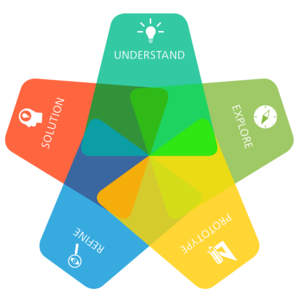This article is part of a series. Refine is #4 of 5.
In this series, Michele Ronsen of Ronsen Consulting explores Design Thinking through blogs and activities. Before reading the article below, check out the first three blogs in the series, which cover the Understand and Explore, and Prototype phases of Design Thinking.
Building a Design Thinking skillset is a practiced process. By the time you’ve completed the first three steps in Autodesk’s Design Thinking process—Understand, Explore, Prototype, Refine, and Solve—you may also have un- knowingly traveled down a path, or multiple paths, that deviated from established criteria in one way or another. While the premise of user-centered design is to include the user every step of the way, it’s plausible that new findings, stakeholders, budget, technology or something within your control has inadvertently modified the direction. This is where Refine comes in—the second to last step in Autodesk’s Design Thinking process.
We’ve already covered Understanding—the step in which we learn how to uncover and grasp wants and needs through practices of empathy. In Exploring, we took strides to define for whom we are designing, what success looks like and then generating ranges of solutions to meet needs. In Prototyping, we reviewed testing, learning, and iterating to validate those proposed solutions.
In the next phase, Refine, we revisit the original design challenge and its success criteria to ensure our solutions are meeting set goals. Here, we take a fresh look at our highest fidelity prototype, review it, and take stock of how it meets the original and possibly revised goals. Remember, these goals may have morphed through the process, or it’s possible that you may have departed from the destination accidentally.
We shouldn’t discount that this can be frustrating; it’s actually helpful to recognize this as part of the process. Deviations are quite common in professional practice for several reasons. Revised success criteria may be out of our control. For example, imagine a new stakeholder was introduced from the client side, and she brings a new mandate to the challenge: a competitor launched a similar solution in the time you were developing yours. Perhaps a new law was passed that impacts your strategy. There are also times when the departure from the path to meet our goals is within our control, which can sometimes be summed up as “tunnel vision”: the inability to see beyond our personal point of focus. Or perhaps we actually saw this departure and chose to ignore it based on perceived low impact.
Sometimes these deviations are unavoidable, and sometimes they aren’t. Regardless, it’s important to go through this exercise of refinement—a procedural gut check, if you will—to validate the design solution against goals.
To do this, we must dissect our solutions at both a detailed, granular level as well as from a thousand foot high-level view. Compare your criteria checklists (the challenges involved mandates combined with the users’ needs, wants and feedback) to the current state of your solution and scrutinize the work. Ask yourself how you are doing within these contexts and perspectives and take stock of what and how your design could benefit from further evolution. Be critical. After all, we’ve moved quickly, our eyes and ears are tired, and we’ve absorbed a ton of information. It’s very likely that something has changed along the way that was out of our control and we missed that new requirement, or we've acquired a narrow-minded or limited perspective. It happens to the best of us!
Building a Design Thinking skillset may seem daunting and tiring at times. The truth is that it can be taxing, regard- less of how long you’ve been practicing. The key is to keep your eyes on the prize. The genuine reward comes when you can meet your users’ needs while simultaneously furthering your skillset. Now is not the time to give up! Refining is an instrumental step. If you avoid revisiting your ideas versus the success criteria and the refinement that follows, you may have significant regrets. Why? Because if you don’t find the holes in your solutions, the people you’re designing for will.
Here are three suggestions on how to refine your design.
First, consider removing elements in isolation. Does everything have a value? Does everything stand up? These could be the application of color, materials used, shape, steps or anything in this vein. What can be eliminated to make your solution simpler? An extra step in a setup flow might cause drop-off. Is there anything that might be considered fluff or gratuitous? An animation might be delightful but might not work on a lower grade device. Be ruthless in your choices; the best experiences are focused, easy to understand and use.
Second, identify your earlier assumptions from exploring and challenge them. Then challenge them again (you remember this part!). List what you know now that you didn't know when you started. Question what you believed to be true at the onset and compare it to what you learned as you journeyed on. What should be tweaked as a result of these deltas? Naturally, you’ve both followed your instincts and held to a process; these led you down your current path. Perhaps you conducted a persuasive interview while in the understanding phase. Perhaps this perspective turned out to be an outlier, and the general need pointed in another direction. Does your solution still cling to this outlier? Now is the time to do your checks and balances.
Third, recall the person or people who provided the most positive feedback. Recall the person or people who provided the most negative feedback. Read your interview notes again and think about how they might respond to your solution in its current state. Then conduct additional interviews to solicit feedback. Reach out to the person or people you wished you had spoken to but didn’t. Use these refreshers as an opportunity to show refined prototypes. And guess what? You may just need to iterate again. It’s all part of the process.
Now, let’s dive into refining.
Here are some exercises that will help you hone your Refine skills. These assignments, together with the Autodesk Design Academy’s Green Space: Urban Planning project can be applied to any design challenge.
The Green Space project features architect and urban planner Riyad Ghannam who challenges you to trans- form a grungy curb into a street-side minipark using AutoCAD. He’ll walk you through the process and explain the design criteria. Use this project’s assignment exercises, as well as the homework assignments to further your own Design Thinking process. Use them as resources to integrate design thinking as a framework in your studies and apply them to any project you choose.
Ready for the final step? Read about the Solution phase of Design Thinking.






